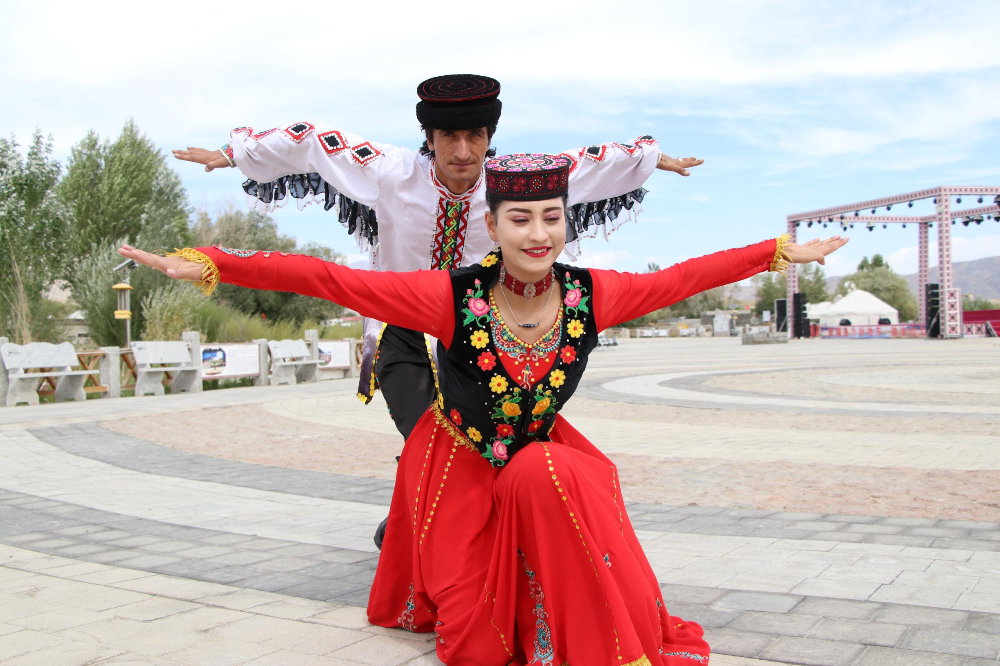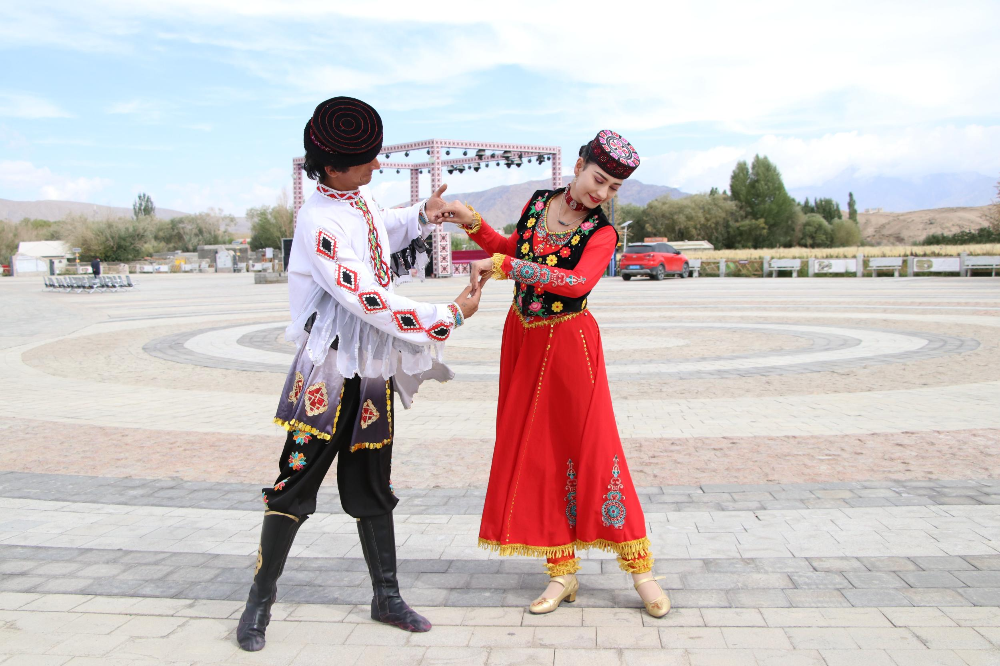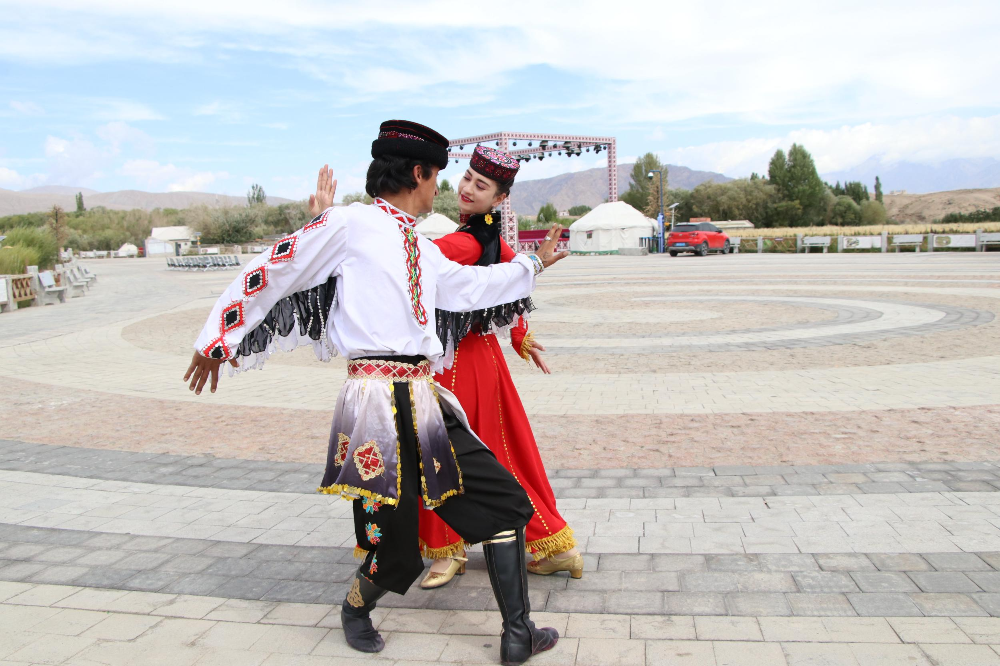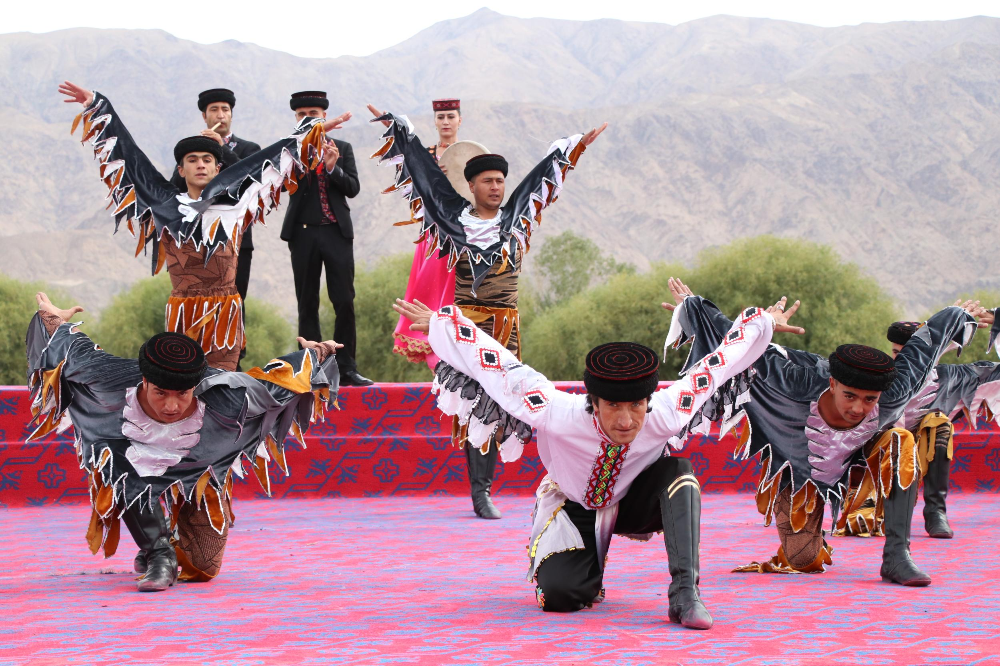Editor's note: From arts and crafts to knowledge and skills, China's intangible cultural heritage is invaluably embedded in its ethnic communities. This series looks at the latest efforts to preserve and promote the country's inherited traditions and living expressions.

Tajik dancers perform the eagle dance at the Pamir tourist area in a western county of the Xinjiang Uygur autonomous region on Sept 1. XING WEN/CHINA DAILY
The eagle is so revered by Tajik people in the far west of the Xinjiang Uygur autonomous region that they perform a dance in its honor.
Visitors to the Pamir area of Tashikurgan Tajik autonomous county can watch performances of the eagle dance during the peak tourist season from May to August.
The Tajik dancers, wearing costumes with sleeves decorated with long feathers, stretch their necks, extend their arms and make spins, imitating a swooping eagle. The performance on an outdoor stage is made more spectacular by the majestic, snow-capped mountains in the distance.
The unusual folk dance is a tradition of the Tajik people who mainly inhabit Tashikurgan, Yarkant, Yecheng and several other counties in Xinjiang.
To local people, the eagle symbolizes honesty, kindness, bravery and strength. Folk songs and stories about the bird of prey are widely shared among Tajik people.
Imitating the eagle's movements gradually developed into a popular dance among Tajik people, performed during festivals and celebrations or as simple entertainment.
The dance is also performed on special occasions such as horse races and mounted sheep-pulling events, called buzkashi, with musicians playing flutes made of eagle bones and drums to cheer on participants.
At the start of the dance, men and women sit in a circle and then choose a partner. The dancers nod and stamp on the ground to mimic eagles frolicking. Sometimes they bend down and bring their arms back behind their bodies to imitate a bird hovering in the air. All movements are graceful and vibrant.
The eagle dance is also considered a traditional art form that has been part of the lifestyles of Tajik people for generations. In 2006, it was registered as a national intangible cultural heritage item.

Tajik dancers perform the eagle dance at the Pamir tourist area in a western county of the Xinjiang Uygur autonomous region on Sept 1. XING WEN/CHINA DAILY
Learning skills
Luchi Jurat, 33, is the leading dancer of the Pamir area troupe, which has more than 40 performers.
He started learning the eagle dance from his father and grandfather when he was 13.
"We often danced together at gatherings, which made me feel very relaxed," he said, adding that his family loved music.
He attended a vocational school in Kashgar in Xinjiang's south and after graduation decided to resume his passion for the eagle dance. He studied with a well-known instructor for two years and improved his dance skills.
In 2009, Luchi became a professional dancer with the Tashikurgan troupe and has since traveled to Urumqi, Xinjiang's capital, Shanghai, Bangkok in Thailand and Dushanbe in Tajikistan, where the troupe performed the eagle dance and had exchanges with performers from different cultural backgrounds.
"I hope that I can visit more places to present the charm of the eagle dance and also learn from other dancers," he said.
When the troupe performs at shows for tourists, Luchi usually prepares for at least three performances.
"Now and then, some tourists came to me and express their desire to learn the dance. And I am regularly invited by local primary schools to teach children how to perform the eagle dance," Luchi said, adding that he wants to inspire more young Tajik people's interest in the traditional dance.
Anayim Niyaz, 23, is Luchi's dance partner.
She has loved dancing ever since she was a child. After graduating from a college in Urumqi, she went back to Tashikurgan and studied the eagle dance. She joined the troupe in 2019 after passing an audition. "Learning the eagle dance is not as easy as I imagined. I had to work harder to hone my skills," she said.

Tajik dancers perform the eagle dance at the Pamir tourist area in a western county of the Xinjiang Uygur autonomous region on Sept 1. XING WEN/CHINA DAILY
Good income
Anayim is pleased she has turned her hobby into her job and she now earns about 6,300 yuan ($930) a month. "For me, it is a decent and stable job," she said, "and it also allows me to stay with my family in my hometown."
Qurban Tohtash, 90, is a State-level inheritor of the eagle dance tradition who receives an annual subsidy of 20,000 yuan from the government.
"My father told me that the eagle dance is the traditional folk dance of our ethnic group, and we'd better learn it conscientiously," he said, adding he started learning the dance at age 15.
Qurban is widely recognized as an outstanding eagle dancer among local Tajiks. He has mastered elegant moves and is also good at playing the eagle bone flute.
Due to his reputation, he is in great demand among villagers as a dance instructor. Two of his students have joined the Tashikurgan troupe.

Tajik dancers perform the eagle dance at the Pamir tourist area in a western county of the Xinjiang Uygur autonomous region on Sept 1. XING WEN/CHINA DAILY
In 2017, a group from the Xinjiang Art Research Institute visited Qurban while they were filming a documentary on the eagle dance and the protection of intangible cultural heritage items.
Qurban said there was an urgent need to pass on the eagle dance to future generations.
"Patience is important for learning the eagle dance," he said. "Today, young people are occupied with working. Many of them go to big cities as migrant workers and we tend to hold fewer gatherings than we used to.
"Compared with yesteryear, fewer people can spare the time to learn the traditional folk dance."
Qurban still dances at family gatherings despite his advanced years. His favorite dance partner is his grandson who is now studying at Shanghai University of Sport.
Every time the grandson returns for a family reunion, they dance together to celebrate.

Tajik dancers perform the eagle dance at the Pamir tourist area in a western county of the Xinjiang Uygur autonomous region on Sept 1. XING WEN/CHINA DAILY








